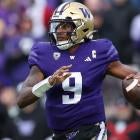
The 2020 NFL Draft was chock full of stud wide receiver prospects. The class was so strong that six of them were eventually drafted in the first round, the second-most since the league expanded to 32 teams in 2002. Throw in the seven second-round picks, and wide receivers accounted for a greater share of selections made in the top two rounds (21 percent) than ever before during this era of the league's alignment.
A year-and-a-half into these players' careers, it's clear that the two most impactful receivers were the third and fifth players off the board at the position: CeeDee Lamb, who went No. 17 overall to the Dallas Cowboys, and Justin Jefferson, who went No. 22 overall to the Minnesota Vikings. The two superstars will go head to head on "Sunday Night Football" when the Cowboys visit the Vikings in Week 8.
Jefferson was named an All-Pro as a rookie, setting an NFL record for receiving yards in a debut season along the way. He finished the year with 88 catches for 1,400 yards and seven touchdowns despite not being a starter in the first two games of the year, and he has continued setting secondaries aflame in his sophomore season. Lamb lost his starting quarterback a third of the way through his rookie campaign but was on track for Jefferson-esque numbers (93-1,386-6) at the time he went down, and wound up with a still-excellent 74-catch, 935-yard, six-touchdown year while mostly catching passes from Andy Dalton, Ben DiNucci, and Garrett Gilbert. With Dak Prescott back on the field, Lamb has picked up right where he left off when Dak originally went down: He's now played 11 games with Prescott under center, and is on a 90-1,352-9 (16-game) pace in those contests.
In their second NFL seasons, Jefferson and Lamb have remarkably similar receiving lines. Jefferson has handled a bit more raw volume (59 targets to Lamb's 49) and thus has the lead in both receptions (41 to 33) and yards (542 to 497). But the two players have been targeted on nearly the exact same percentage of their routes run (24% for Jefferson, 23.3% for Lamb, per TruMedia tracking), while Lamb has been slightly more efficient on a per-route basis (2.37 yards per route run vs. 2.20), and he has created both first downs (49% of targets vs. 44.1%) and explosive plays (22.4% of targets vs. 18.6% ) a bit more often than his counterpart.
What I find most fascinating about the two receivers is that the way they're coming by their production is actually quite a bit different -- both from each other and from what we might have expected of them coming out of college.
Jefferson, for example, was (clearly unfairly) pigeonholed by some teams as a slot-only receiver coming out of LSU. According to Pro Football Focus, he played in the slot 78% of the time in his final college season; he was absolutely dominant in that role, thanks in large part to the free releases off the line that it allowed him. In the pros, though, Jefferson has aligned inside on only 23.8% of his routes, and he's obviously been just fine.
His defining feature is his ability to win by a little bit at every stage of a route. He wins by a little bit on the release, a little bit on the break, and a little bit at the catch point -- and it all ends up with him being a lot more open than you might have expected him to be based on what happened at each of those individual stage. He's received an average of 5.2 yards of pre-snap cushion on his routes this season, per NFL.com's Next Gen Stats, but has allowed defenders to close the gap by only 2.4 yards by the time of the catch. Among 81 receivers with 20-plus targets, that differential is 18th-smallest, putting him just behind only Tyreek Hill, Keenan Allen, DeAndre Hopkins, Mike Williams, and a bunch of slot-only receivers.
Considering he ranked in the 80th percentile or better in the 40-yard dash, 10-yard split, vertical jump, and broad jump at the NFL Scouting Combine, it makes sense that he is able to manufacture small margins throughout each play.
Like Jefferson, Lamb has also been used in different ways than he was in college. He was more of an inside-outside threat at Oklahoma than Jefferson was at LSU, but as a rookie, Dallas used Lamb in the slot on 91.2% of his routes -- the highest rate in the league among players who averaged at least 10 snaps per game. Some of that was due to the presence of Michael Gallup (a prototypical X receiver if there ever was one) and Amari Cooper, but some was due to the desire to simplify things for an uber-talented player they wanted on the field right away. This season, Lamb's splits have flipped: He's only been in the slot 22% of the time, compared with 76% out wide. Gallup's Week 1 injury obviously affects that and we're likely to see more balance going forward, but the Cowboys also came into the year with the plan to move their receivers around much more often, and that has been borne out so far.
Lamb is also a bit different than Jefferson. He's a great route-runner, too, but for a much different reason. Rather than winning by a little bit at each stage of the route, Lamb just wins by a whole lot at one stage or another, depending on the play. His 99th-percentile 10-yard split highlights his ability to suddenly generate a ton of room very quickly, at whichever stage of the route it becomes necessary.
Sometimes it's a great release and he's wide open practically before the play even starts. Sometimes it's a stop-start break that creates a few yards of separation. Sometimes it's holding off the defender at the point of the catch, sometimes it's with elite body control that enables him to make a grab that doesn't seem like it should be made, and sometimes it's with his incredible ability to generate additional yardage with the ball in his hands. Lamb is averaging 6.97 yards after catch per reception, per TruMedia, seventh-best among the aforementioned group of 81 wideouts. He's also averaging 2.7 yards after catch over expectation, according to Next Gen Stats, the ninth-best mark among 124 qualifiers.
Contrasting their skills by showing a couple of their best plays from this season perhaps exemplifies the difference between the two players: Jefferson's subtle ability to generate late separation and make contested catches turns potentially incomplete passes into easy completions, while Lamb's body control and YAC-generation help generate chunk gains that maybe shouldn't have been chunk gains.
It's not like they're completely different players, though. Both Jefferson and Lamb have outrageously good stutter-releases off the line of scrimmage, for example. Easing into the route, giving a quick chop of the feet, and exploding past the defender and into space is as good a way as any to get open for your quarterback, and they each excel in that area. That they can do it against cornerbacks like Denzel Ward, James Bradberry, Donte Jackson, and a fairly helpless Jalen Mills makes it even more impressive.
Each just 22 years old, it's clear that both Lamb and Jefferson have a lot of football ahead of them. If the beginning of their respective careers is any indication, they are going to catch a whole lot of passes and make a whole lot of highlights along the way. Buckle in, because it's going to be incredibly fun to watch them do it.






















